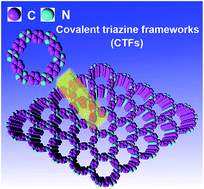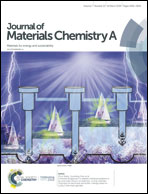Covalent triazine frameworks: synthesis and applications
Abstract
Covalent triazine frameworks (CTFs) represent an exciting new type of porous organic material (POP), which have some unique characteristics, i.e., aromatic C![[double bond, length as m-dash]](https://www.rsc.org/images/entities/char_e001.gif) N linkage (triazine unit) and the absence of any weak bonds. In particular, the strong aromatic covalent bonds endow CTFs with high chemical stability and rich nitrogen content, which bring great value for many practical applications and the interesting heteroatom effect (HAE). The unique properties make CTFs attractive for various applications, such as separation and storage of gases, energy storage, photocatalysis and heterogeneous catalysis. Based on the current status of research, CTFs can be classified into two categories, i.e., amorphous and crystalline CTFs. Since 2008, a series of synthetic strategies have been developed, i.e., an ionothermal trimerization strategy, a phosphorus pentoxide (P2O5) catalyzed method, amidine based polycondensation methods, a superacid catalyzed method and a Friedel–Crafts reaction method. The advent of these methodologies has prompted researchers to construct well-defined crystalline CTFs. This critical review systematically summarizes the development and challenges in the synthesis and potential applications of CTFs.
N linkage (triazine unit) and the absence of any weak bonds. In particular, the strong aromatic covalent bonds endow CTFs with high chemical stability and rich nitrogen content, which bring great value for many practical applications and the interesting heteroatom effect (HAE). The unique properties make CTFs attractive for various applications, such as separation and storage of gases, energy storage, photocatalysis and heterogeneous catalysis. Based on the current status of research, CTFs can be classified into two categories, i.e., amorphous and crystalline CTFs. Since 2008, a series of synthetic strategies have been developed, i.e., an ionothermal trimerization strategy, a phosphorus pentoxide (P2O5) catalyzed method, amidine based polycondensation methods, a superacid catalyzed method and a Friedel–Crafts reaction method. The advent of these methodologies has prompted researchers to construct well-defined crystalline CTFs. This critical review systematically summarizes the development and challenges in the synthesis and potential applications of CTFs.

- This article is part of the themed collection: Recent Review Articles


 Please wait while we load your content...
Please wait while we load your content...